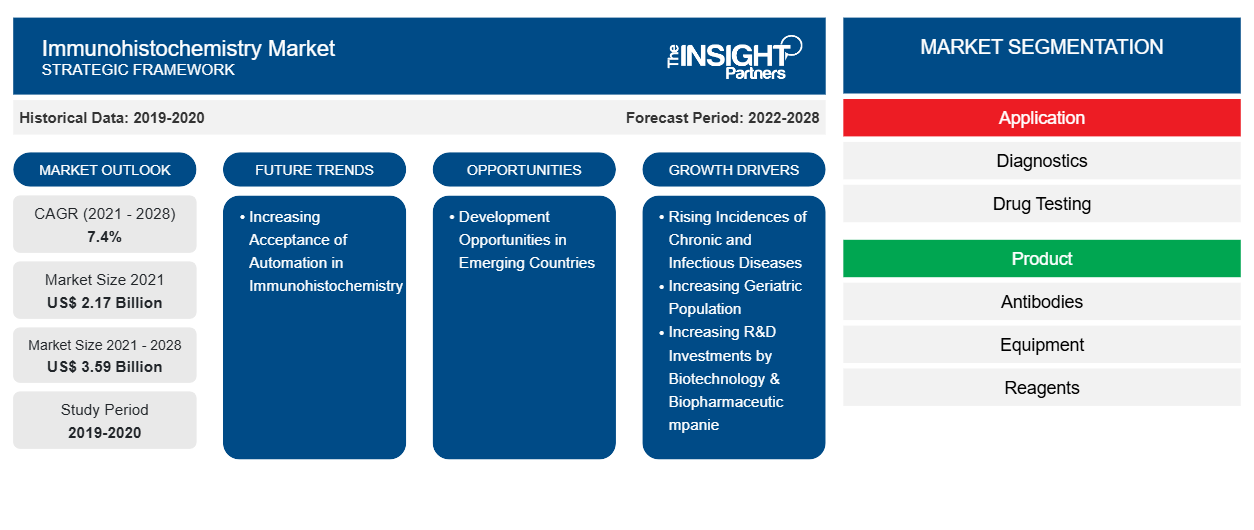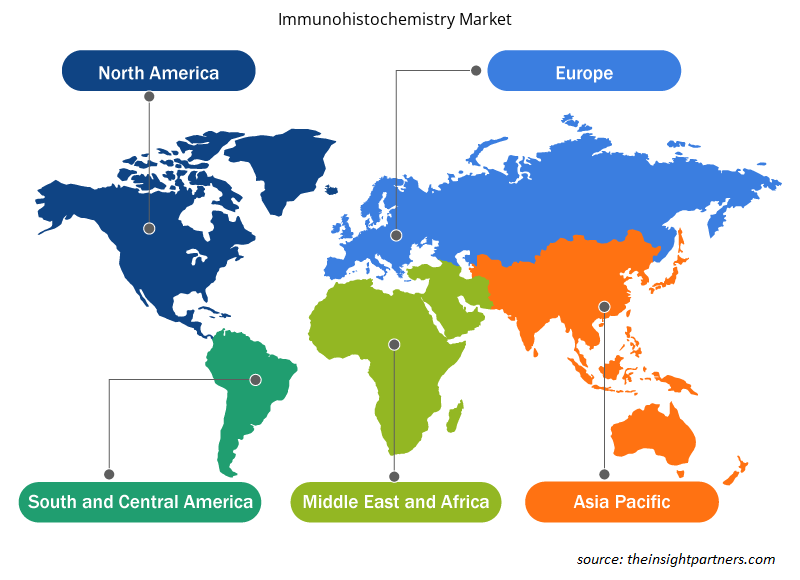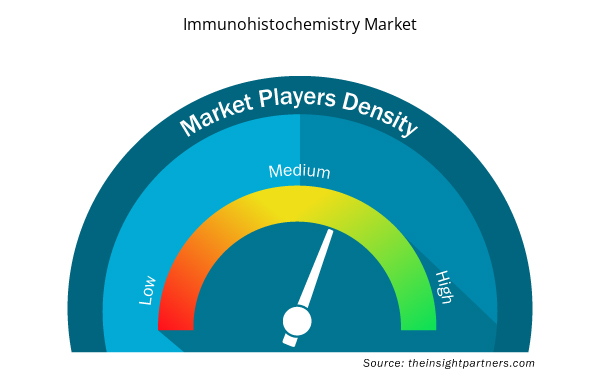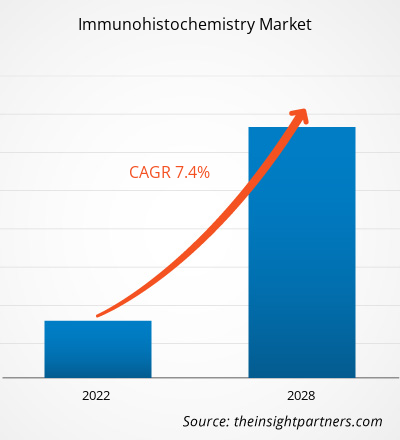[Research Report] The immunohistochemistry market is projected to reach US$ 3,585.31 million by 2028 from US$ 2,171.61 million in 2021; it is estimated to register a CAGR of 7.4% from 2021 to 2028.
Market Insights and Analyst View:
Immunohistochemistry (IHC) is a tool used microscopy-based techniques to observe cellular components such as proteins or other macromolecules in a tissue sample. It is routinely used tool in health care and pathology. IHC is widely used in research application where molecules of interest are analysed to study their roles in both healthy and diseased cells and tissues on the cellular, molecular, or tissue level. There are numerous IHC methods that can be used to localize antigens. Parameters like specimen types and assay sensitivity are majorly considered in IHC. The global immunohistochemistry ihc market size is expected to reach US$ 3,585.31 million in 2028 from US$ 2,1716.1 million in 2021. The market is estimated to grow with a CAGR of 7.4% from 2021-2028.
Growth Drivers and Challenges:
Rising Incidences of Chronic and Infectious Diseases
Immunohistochemistry (IHC) refers to an important application monoclonal and polyclonal antibody for tissue determination and distribution of antigens of particular disease. It is majorly used to detect several infectious disorders like dengue, hepatitis, human immunodeficiency virus (HIV). Chronic medical conditions such as obesity, cancer, diabetes, heart disease, and stroke, are also considered to be the primary major applications of immunohistochemistry that helps in the diagnosis of these diseases.
According to the Joint United Nations Programme on HIV/AIDS (UNAIDS), there were approximately 37.6 million people across the globe with HIV in 2020. Of these, 35.9 million were adults and 1.7 million were children (<15 years old). An estimated 1.5 million individuals worldwide acquired HIV in 2020. According to the HIV and AIDS organization (AVERT), in 2018, 1.1 million U.S. residents were infected with HIV, whereas APAC registered 5.2 million HIV-infected population. According to the European CDC, ~2 million people in Europe were infected with HIV in 2018.
Diabetes is prevailing at a high rate in the geriatric population worldwide. The prevalence of diabetes is more in overweight and obese people. As per data published by the Center for Disease Control and Prevention (CDC) in 2017, ~30.3 million people, representing 94% of the population of the U.S., are diabetic. Among these, ~23.1 million people are diagnosed with diabetes, while ~7.2 million people have not undergone a proper diagnostic procedure.
The obesity rates have been increasing rapidly in developed as well as developing economies across the globe. Factors such as unhealthy lifestyle and sedentary life are among the major for the rise in the number of obese individuals. As per data published by National Center for Health Statistics (NCHS), the prevalence of obesity is expected to be around 39.8%, affecting about 93.3 million of U.S. adults between the years 2015 to 2016. The incidences of obesity were observed to be significantly high among middle-aged adults (42.7%) as compared to younger adults (35.7%). The increase in the number of obese people in the United States has led to rising healthcare expenditure as well.
Cardiovascular diseases (CVDs) include cerebrovascular disease, rheumatic heart disease, coronary heart disease, and other conditions. It is the most significant cause of morbidity and mortality worldwide. According to the European Cardiovascular Disease Statistics 2017, every year, cardiovascular disease causes 3.9 million deaths and more than 1.8 million deaths in the European Union (E.U.). The CVD accounts for 45.0% of all deaths in Europe, and 37.0% of deaths in E.U. Furthermore, as per the American Heart Association (AHA) 2019 statistics, 121.5 million adults in the U.S. which are around half of the U.S. adult population, suffer from cardiovascular disease.
Furthermore, there has been a rise in cancer incidence and mortality rates all over the world, making cancer the leading cause of death. According to the World Health Organization in 2018, approximately 9.6 million deaths around the globe were due to cancer.
Moreover, the National Cancer Institute predicted that in 2018, approximately 1,735,350 new cancer cases would be diagnosed in the U.S. Similarly, in China, as per the data revealed by WHO, ~4.3 million new cases of cancer were detected as well as 2.9 million cancer deaths were recorded in 2018. Such an increase in the incidence of chronic and infectious diseases is expected to create a demand for immunoassay tests around the world.
Customize This Report To Suit Your Requirement
You will get customization on any report - free of charge - including parts of this report, or country-level analysis, Excel Data pack, as well as avail great offers and discounts for start-ups & universities
Immunohistochemistry Market: Strategic Insights

- Get Top Key Market Trends of this report.This FREE sample will include data analysis, ranging from market trends to estimates and forecasts.
Customize This Report To Suit Your Requirement
You will get customization on any report - free of charge - including parts of this report, or country-level analysis, Excel Data pack, as well as avail great offers and discounts for start-ups & universities
Immunohistochemistry Market: Strategic Insights

- Get Top Key Market Trends of this report.This FREE sample will include data analysis, ranging from market trends to estimates and forecasts.
Market Restraints
Limitations Associated with Immunohistochemistry
Immunohistochemistry employs the specificity of antibodies to detect target molecules among tissues or cells. Moreover, IHC has also proven to be a powerful technique in investigative toxicology. However, some of the limitations associated with the specificity and accuracy of the technique confine its adoption at a certain level.
Lack of specificity of reagents is a problem that is more common than is generally recognized. The lack of specificity may result in tremendous waste in terms of resources and time. Moreover, the application of the technique is also limited by the physical limitations of the antibodies. Furthermore, immunohistochemistry can be misleading if the staining study design is not carefully conceived and controlled.
Although this system is the simplest and the most convenient method for the detection of given marker expression, it is not effectively employed in clinical and research applications due to limitations such as insufficient sensitivity, need for each primary antibody to be individually conjugated with fluorophores or enzymes and staining issues. Thus, the limitations associated with the IHC technique can hamper the market growth to a certain extent.
Report Segmentation and Scope:
The “Global Immunohistochemistry Market” is segmented based on application, product, end user, and geography. The global immunohistochemistry market, based on products, has been segmented into antibodies, equipment, reagents, and kits. The global immunohistochemistry market, based on appplication is segmented into diagnostics and drug testing. In 2021, the diagnostics segment is likely to hold the largest share of the market. Global immunohistochemistry market, based on end user was segmented into hospital & diagnostic laboratories, research institutes, and others. The immunohistochemistry market, based on geography is segmented into North America (US, Canada, and Mexico), Europe (Germany, France, Italy, UK, Russia, and Rest of Europe), Asia Pacific (Australia, China, Japan, India, South Korea, and Rest of Asia Pacific), Middle East & Africa (South Africa, Saudi Arabia, UAE, and Rest of Middle East & Africa), and South & Central America (Brazil, Argentina, and Rest of South & Central America)
Segmental Analysis:
Based on product, has been segmented into antibodies, equipment, reagents, and kits. The antibodies segment is likely to hold the largest share of the market in 2021. Moreover, the reagent segment is anticipated to register the highest CAGR in the market during the forecast period, due to their incumbent usage, high volume consumption, and product innovation. Reagents allow researchers to conduct an in-depth analysis of tissues and assays at an exceptional level. Commonly reagents used in immunohistochemistry include histological stains, blocking & fixation reagents, chromogenic substrates, stabilizers, solvents, and proteolytic enzymes, among others. Thermo Fisher Scientific Inc., Abcam plc., and Enzo Life Sciences, Inc., QIAGEN, Bio-Rad Laboratories are some of the major players in this segment. Novel reagents also enable enhanced specifications for the precise and accurate data amount and quality, along with excellent service results Incumbent usage of reagents, growing R&D expenditure, growing government support and technological innovation are among the factors that are expected to strengthen the growth of the reagents segment during the forecast period.
The global immunohistochemistry market, based on application is segmented into diagnostics and drug testing. In 2021, the diagnostics segment is likely to hold the largest share of the market. Moreover, the segment is also expected to witness growth in its demand at a fastest CAGR during 2021 to 2028, owing to the rise in the detection and diagnosis of various medical conditions across the globe. Diagnosis of the various chronic diseases such as cancer, autoimmune diseases, infectious diseases, and nephrological diseases, among others through immunohistochemistry, have become various efficient. The use of the antibodies, reagents, dyes, and other molecular diagnostics tools makes vital information available quickly and in less period.
The use of immunohistochemistry interprets the diagnosis accurately and offers clinicians with the best therapeutic methods for the treatment. The other advantages of the immunohistochemistry include identification of genetic and molecular causes of a disease that may help in providing the best therapeutic method and patient care. It also helps in the therapeutic applications that enable in evaluating the therapeutic techniques based on the immunological results.
Also, immunohistochemistry techniques are cost-effective than other medical diagnostics. The immunohistochemistry diagnosis utilizes a few hundred dollars as compared to the medical diagnostics. Moreover, technological advancements have made easy availability of antibodies and molecular diagnostics tools. Therefore, owing to the advantages of immunohistochemistry in the diagnosis of diseases, it is estimated that the market is likely to grow exponentially during the forecast period. Global immunohistochemistry market, based on end user was segmented into hospital & diagnostic laboratories, research institutes, and others. In 2021, the hospital & diagnostic laboratories segment is likely to hold the largest share of the market, by end user. In addition, the segment is also expected to grow at the fastest rate during the coming years owing to the rise in the prevalence of infectious diseases, cancer and autoimmune disorders. The rise in the cases of these disorders is expected to drive the need for its diagnosis, hence leading to the growth of the segment. Hospitals are among the essential parts of the healthcare system of any country. Technological advancements aid hospitals in diagnosing and treating various disorders such as cardio, neuro, HIV, Hepatitis, oncology, and others. The hospital provides extensive healthcare and medical services to patients suffering from a variety of diseases and disorders. Nowadays, hospitals give better services to their patients. Usually, such hospitals offer diagnostic and treatment services for multiple indications. Enormous patients are admitted for the procedure while several patients walk in for the diagnostics treatment. Among the admitted patients, most of them are already suffering from some disorders. Therefore, to monitor and control their health in real-time, most hospitals are attached to clinical diagnostic laboratories. Thus, hospitals contribute a significant market share to the immunohistochemistry market and are expected to continue the trend during the forecast period.
Diagnostic centers offer a complete analysis of tissue, cell, and body fluid that provide comprehensive diagnostics to ensure the highest quality services and care to patients’ needs. The diagnostic centers have modern diagnostic and pathological equipment and instruments such as biochemistry analyser, haematology analyser, diagnostic test kits, PCR, gel electrophoresis, and others. The pathology and diagnostic centre allow patients to receive a detailed report from the on-site pathologist within few hours to days. For instance, Laboratory Corporation of America Holdings, founded in 1978, is among the leading diagnostic laboratories that offer a full array of pathological and diagnostic services. LabCorp has earned a distinct reputation for quality and compassionate patient care. The advances in pathological technologies providing quick and accurate results in low turnaround time is likely to propel the growth of pathology and diagnostic centers segment over the forecast years.
Immunohistochemistry Market Analysis, Regional Analysis:
Based on geography, the immunohistochemistry market is divided into five key regions: North America, Europe, Asia Pacific, South & Central America, and Middle East & Africa. North America is the largest market for immunohistochemistry, and the US, Canada, and Mexico are the major contributors to the market in this region. The growth of the North American market is characterized by the growing prevalence of cancer and corresponding growth in cancer diagnostic tools, technological advancements in immunohistochemistry techniques and rising geriatric population. In addition, growing healthcare expenditure is likely to be a major growth stimulator for the immunohistochemistry market in North America.
Industry Developments and Future Opportunities:
Various initiatives taken by key players operating in the global immunohistochemistry market are listed below:
- In July 2021, PD-L1 IHC 22C3 pharmDx of Agilent Technologies Inc. Expands CE-IVD mark in Non-small Cell Lung Cancer (NSCLC). It is labeled for extended use in patients with NSCLC in the European Union. It can now use in identifying NSCLC patients with tumor PD-L1 expression of Tumor Proportion Score (TPS) 50% for treatment with Libtayo (cemiplimab).
- In April 2020, Bio-Rad launched a blood-based immunoassay kit to detect Covid-19. It is a blood-based immunoassay kit to identify antibodies to the SARS-CoV-2, the virus that causes Covid-19.
- In September 2020, Thermo Fisher and Humanigen agreed to scale up the manufacturing of monoclonal antibodies for COVID-19. This business deal is expected to help scale up manufacturing the California biotech's lenlizumab, a clinical-stage candidate for cytokine storm that the company was testing in severe COVID-19 patients for a possible emergency use approval following this year.
Immunohistochemistry Market Regional Insights
The regional trends and factors influencing the Immunohistochemistry Market throughout the forecast period have been thoroughly explained by the analysts at Insight Partners. This section also discusses Immunohistochemistry Market segments and geography across North America, Europe, Asia Pacific, Middle East and Africa, and South and Central America.

- Get the Regional Specific Data for Immunohistochemistry Market
Immunohistochemistry Market Report Scope
| Report Attribute | Details |
|---|---|
| Market size in 2021 | US$ 2.17 Billion |
| Market Size by 2028 | US$ 3.59 Billion |
| Global CAGR (2021 - 2028) | 7.4% |
| Historical Data | 2019-2020 |
| Forecast period | 2022-2028 |
| Segments Covered |
By Application
|
| Regions and Countries Covered | North America
|
| Market leaders and key company profiles |
Immunohistochemistry Market Players Density: Understanding Its Impact on Business Dynamics
The Immunohistochemistry Market market is growing rapidly, driven by increasing end-user demand due to factors such as evolving consumer preferences, technological advancements, and greater awareness of the product's benefits. As demand rises, businesses are expanding their offerings, innovating to meet consumer needs, and capitalizing on emerging trends, which further fuels market growth.
Market players density refers to the distribution of firms or companies operating within a particular market or industry. It indicates how many competitors (market players) are present in a given market space relative to its size or total market value.
Major Companies operating in the Immunohistochemistry Market are:
- F. Hoffmann-LA Roche AG
- Merck KGaA
- PerkinElmer, Inc.
- Thermo Fisher Scientific, Inc.
- Abcam Plc
Disclaimer: The companies listed above are not ranked in any particular order.

- Get the Immunohistochemistry Market top key players overview
Covid-19 Impact:
The breakout of the COVID-19 pandemic in North America had a significant impact on the United States. The country has the highest number of patients who have tested positive. Various healthcare research centers across the country were solely focused on COVID 19 treatments. The COVID-19 has affected economies and industries in various countries due to lockdowns, travel bans, and business shutdowns. The COVID-19 crisis has overburdened public health systems in many countries and highlighted the strong need for sustainable investment in health systems. As the COVID-19 pandemic progresses, the healthcare industry is expected to see a drop in growth. The life sciences segment thrives due to increased demand for invitro diagnostic products and rising research and development activities worldwide. However, the medical technologies and imaging segment is witnessing drop in sales due to a smaller number of surgeries being carried out and delayed or prolonged equipment procurement. Additionally, virtual consultations by healthcare professionals are expected to become the mainstream care delivery model post-pandemic. With telehealth transforming care delivery, digital health will continue to thrive in coming years. In addition, disrupted clinical trials and the subsequent delay in drug launches is also expected to pave the way for entirely virtual trials in the future. New technologies such as mRNA is expected to emerge and shift the pharmaceutical industry and market is also expected to witness more vertical integration and joint ventures in coming years.
Competitive Landscape and Key Companies:
Some of the prominent players operating in the global immunohistochemistry market include F. Hoffmann-LA Roche AG, Merck KGaA, PerkinElmer, Inc., Thermo Fisher Scientific, Inc., Abcam Plc, Agilent Technologies, Bio SB, Bio-Rad Laboratories, Cell Signaling Technology, Inc., and Danaher Corporation among others. These companies focus on new product launches and geographical expansions to meet the growing consumer demand worldwide and increase their product range in specialty portfolios. They have a widespread global presence, which provides them to serve a large set of customers and subsequently increases their market share.
- Historical Analysis (2 Years), Base Year, Forecast (7 Years) with CAGR
- PEST and SWOT Analysis
- Market Size Value / Volume - Global, Regional, Country
- Industry and Competitive Landscape
- Excel Dataset



Report Coverage
Revenue forecast, Company Analysis, Industry landscape, Growth factors, and Trends

Segment Covered
Application, Product, End User and Geography

Regional Scope
North America, Europe, Asia Pacific, Middle East & Africa, South & Central America

Country Scope
Argentina, Australia, Brazil, Canada, China, France, Germany, India, Italy, Japan, Mexico, Saudi Arabia, South Africa, South Korea, Spain, United Arab Emirates, United Kingdom, United States
Frequently Asked Questions
Asia-Pacific is the lucrative for the immunohistochemistry market.
Immunohistochemistry is a tool used microscopy-based techniques to observe cellular components such as proteins or other macromolecules in a tissue sample. It is routinely used tool in health care and pathology. IHC is widely used in research application where molecules of interest are analyzed to study their roles in both healthy and diseased cells and tissues on the cellular, molecular, or tissue level. There are numerous IHC methods that can be used to localize antigens. Parameters like specimen types and assay sensitivity are majorly considered in IHC.
Key factors driving the growth of the market are rising incidences of chronic and infectious diseases, increasing geriatric population, and increasing R&D investments by biotechnology & biopharmaceutical companies are among the key factors driving the market.
Development opportunities in emerging countries are likely to fuel the market growth in the comping years.
Increasing acceptance of automation in immunohistochemistry is likely to act as trend the market growth in the comping years.
Key players in the market are F. Hoffmann-LA Roche AG, Merck KGaA, PerkinElmer, Inc., Thermo Fisher Scientific, Inc., Abcam Plc, Agilent Technologies, Bio SB, Bio-Rad Laboratories, Cell Signaling Technology, Inc., and Danaher Corporation among others.
Antibodies is the most influencing segment growing in the immunohistochemistry market.
Trends and growth analysis reports related to Life Sciences : READ MORE..
The List of Companies - Immunohistochemistry Market
- F. Hoffmann-LA Roche AG
- Merck KGaA
- PerkinElmer, Inc.
- Thermo Fisher Scientific, Inc.
- Abcam Plc
- Agilent Technologies
- Bio SB
- Bio-Rad Laboratories
- Cell Signaling Technology, Inc.
- Danaher Corporation

 Get Free Sample For
Get Free Sample For